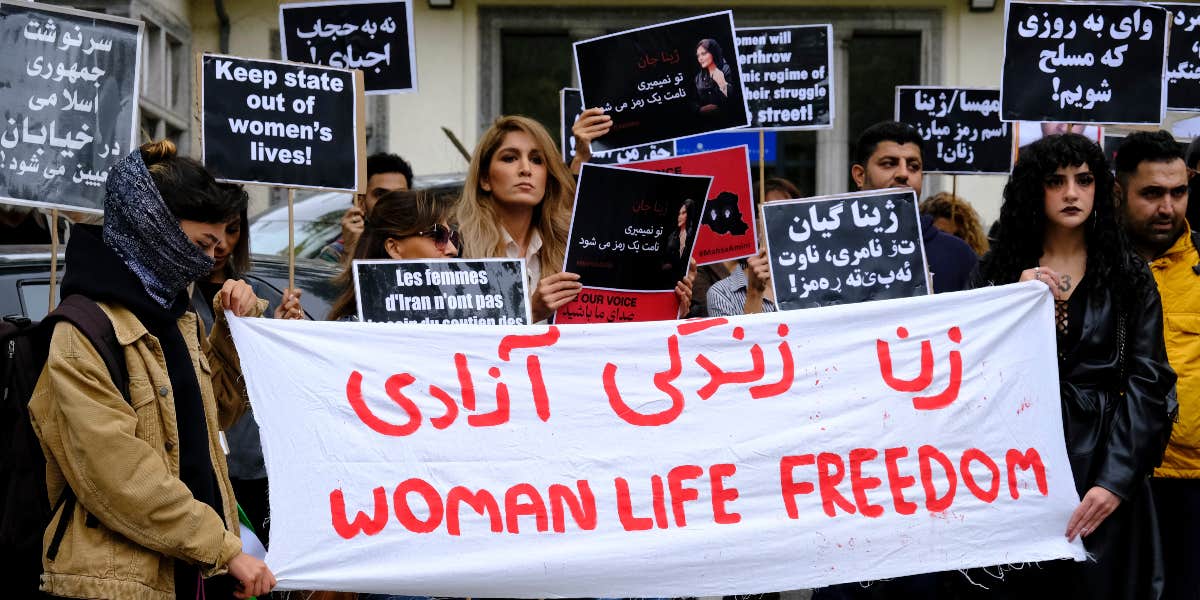Women In Iran Aren't Just Fighting For Themselves — Their Protests Are For Women Everywhere
We should be grateful to them.
 Alexandros Michailidis / Shutterstock
Alexandros Michailidis / Shutterstock On September 16, 2022, 22-year-old Mahsa Amini died in Tehran, Iran while being detained by police.
In the aftermath of her suspicious death, protests have erupted across the nation.
Amini had been arrested by the Iranian “morality police” for failing to properly secure her hijab.
RELATED: Video Shows Iranian Men Defending Woman Who Was Slapped By Stranger During Women’s Rights Protests
The government claims that the young woman died from a pre-existing heart condition, but the Iranian citizens believe she was beat to death.
Since Mahsa’s death, anti-regime protests have started in the capital and across Western Iran.
Woman have defiantly removed their hijabs and chanted, “death to the dictator” in reference to the Supreme Leader, Ayatollah Ali Khamenei.
Dozens of protestors have been killed and hundreds arrested in the violent confrontations that have taken place since, but the women of Iran are not backing down, determined to finally see themselves free of the oppression that has long plagued them.
But, Iranian women are not just fighting for themselves — their fight is for women everywhere.
Across the globe, women are being denied freedom.
While Muslim women in Iran are burning their hijabs, Muslim women in France are fighting for their right to wear one.
In the US, women are being denied control over their reproductive health.
All these protests and fights are about choice and, for women in Iran and across the globe, the loss and denial of choice could be life-threatening.
The domination of and violence against Iranian women is not new.
They have faced over 40 years of oppression by the patriarchal government, and they have had enough.
Before the current regime came into power in 1979, women of Iran had access to higher education, prestigious careers with equal pay, reproductive rights, and could vote and hold political office.
Women had the right to choose what clothing they wore and created systemic change through activism.
They even passed a Family Protection Law eliminating polygamy and mandating more equitable marriages.
That all changed in 1979 when the Family Protection Law was overturned by Khamenei.
The Iranian women did not take the news lying down — for three days, the determined women marched in protest compelling the Supreme Leader to back down.
The victory was short-lived because, by 1980, Khamenei had grown his political power, mandated veiling for women and discharged all the female judges in the country.
RELATED: Video Of U.S. Navy Veteran Cutting Up Her Uniform To Defend Women’s Rights Causes Outrage
Over the next several decades, women saw their rights to autonomy further diminished.
The Islamic Republic placed restrictions on their marriage, divorce, and child custody rights.
The age a girl could legally marry was reduced to 9, then to 13, women required the authorization of a male guardian to leave the country, anyone that objected was arrested or worse and many Iranian feminists went into voluntary exile, choosing to fight the civil rights battle from afar.
In the 1990’s, a time known as the “Pink Revolution” started in Iran.
Rebellious women started wearing makeup and colorful head scarves and making their own conservative choices in clothing.
So many women joined the silent protest that the police did not have to resources to stop them.
That small success gave the Iranian women the confidence they needed to push forward.
Since then, they have quietly and consistently continued to band together and make sure everyone woman gets the basic human rights she is entitled to.
Particularly, the women of Iran have organized en masse to resist the mandatory veiling imposed on them.
There has been an influx of videos on social media showing us the harassment and inhumane treatment they face when choosing to simply wear their own hair.
The suspicious death of Amini seems to have erupted a powder keg of emotion that the Iranian women had been holding back for their entire lives.
Her death meant that the Iranian government didn’t care about women’s rights or their lives.
Despite the shocking action the government is taking to silence them once again, the women continue to fight back, determined to stand their ground.
This time around, the demand is simple, end the subordination of women and the theocratic ideology.
Women want the right to choose whether they wear a hijab, and why should any person be deprived of the right to choose what goes on their body?
The Iranian Republic has used every tactic to stop the uprising.
The citizens have had their phones and internet service restricted, limiting vital communication with the outside world.
Still, the understandably furious women persist in their quest for equity and equality.
Sitting in the privileged comfort of our own living rooms, it is hard to imagine living under such an oppressive regime's rule.
Women around the world are taking notice and figuring out what they can do to help.
We understand how our experiences as women in this world are interconnected.
We get that we are stronger together and need to stand together.
The Iranian women are leading the charge with the kind of courage and bravery most of us could never fathom.
This time, they just might win.
NyRee Ausler is a writer from Seattle, Washington, and author of seven books. She covers lifestyle, entertainment and news, and self-focused content, as well as navigating the workplace and social issues.

